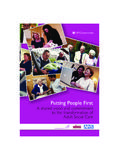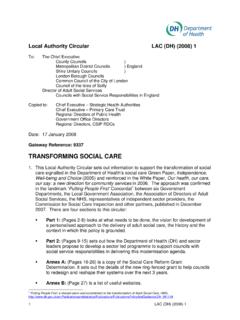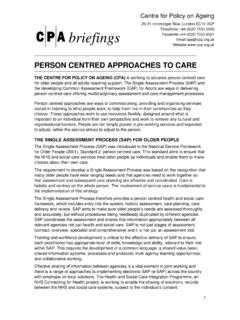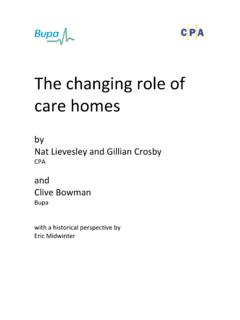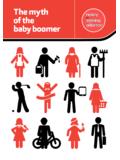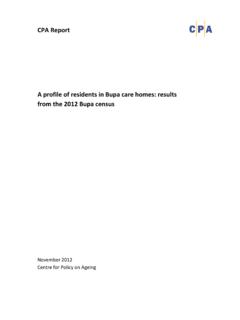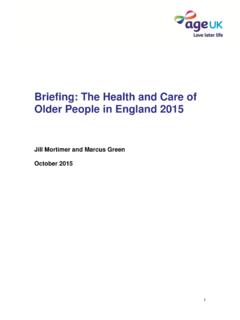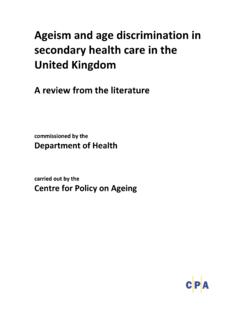Transcription of Loneliness – evidence of the effectiveness of interventions
1 Centre for Policy on Ageing Rapid review March 2014 Loneliness evidence of the effectiveness of interventions Background Loneliness , a state of mind , should be distinguished both from social isolation, an external experience of reduced social contact, and from social exclusion, the ways in which society is organised which exacerbate social isolation in a particular group of individuals. Living alone, although possibly a contributory factor to social isolation and Loneliness , should not in any way be conflated with Loneliness . Loneliness , a mental state arising from a perceived lack of social contact, and social isolation, an actual lack of social contact, are important factors leading to lower levels of health and well being.
2 Social isolation is associated with raised blood pressure, poor physical health, increased mortality and poorer mental health including depression, suicide and dementia. The health risk associated with social isolation is comparable to that associated with Researchers distinguish social and emotional Loneliness . Social Loneliness links closely to social isolation the distance between the existing and desired number and quality of social contacts. Emotional Loneliness refers specifically to not having a close emotional attachment, for example a partner or best friend. Although these two types of Loneliness share a number of characteristics, they also have distinct, measurable, features.
3 It is also important to note that Loneliness is not the same as depression2. It is useful to identify causal and other factors closely identified with Loneliness as interventions that address these factors will, at the same time, address Loneliness . interventions to address Loneliness may be addressed directly at an individual, at groups of people or at the neighbourhood or environment in which those people live. 1 Iliffe S et al (2007) Health risk appraisal in older people 2: the implications for clinicians and commissioners of social isolation risk in older people, British Journal of General Practice 57 (537) : 277 282 2 Fenney D (2013) "Let's start assessing not assuming".
4 A report about the approaches to tackling social isolation within Welsh local authorities 1 Centre for Policy on Ageing Rapid review March 2014 The UK Campaign to end Loneliness toolkit for health and wellbeing boards ( ) adopts the following useful way of categorising interventions to combat Loneliness . Information and signposting services websites or directories including information about social support services; telephone help-lines providing information about social support services; health and social support needs assessment services (postal or web based questionnaires or visits). Support for individuals befriending visits or phone contact, it may include assistance with small tasks such as shopping; mentoring usually focused on helping an individual achieve a particular goal, generally short term; buddying or partnering helping people re-engage with their social networks, often following a major life change such as bereavement; Wayfinders or Community Navigator initiatives helping individuals, often those who are frail or vulnerable, to find appropriate services and support (eg Dorset Wayfinders).
5 Group interventions social day centre services such as lunch clubs for older people; social groups which aim to help older people broaden their social circle, these may focus on particular interests for example, reading. (eg: Brendoncare) Group interventions cultural initiatives that support older people to increase their participation in cultural activities ( use of libraries and museums); community arts and crafts activities (eg: Craft Caf ); local history and reminiscence projects. Health promotion interventions fitness classes for people over 50; healthy eating classes for people over 50.
6 Wider community engagement projects that encourage older people to volunteer in their local community (for example, local volunteer centres and Time Banks). In other cases, the delivery mechanism may be the focus of attention, for example telephone befriending schemes, or the use of information technology and the internet or videoconferencing to improve social involvement and reduce Loneliness . Loneliness , as a state of mind , has a number of other causal, or at least strongly associated, factors, for example, living alone, social isolation, bereavement, being divorced or never married, age 85 or over, being in poor health, having a disability or sensory or cognitive impairment or living in an area with high levels of material deprivation or crime.
7 Broader societal measures, for example improved and safer neighbourhoods, measures to reduce crime, or the maintenance of bus and freedom passes to reduce social isolation, will, at the same time, reduce Loneliness . 2 Centre for Policy on Ageing Rapid review March 2014 Reducing Loneliness may be a desirable end in itself, improving the wellbeing of the individual, but Loneliness is also associated with poor health. Loneliness and stressful social ties contribute to a higher risk of disability, poor recovery from illness, and early death. The magnitude of health risk associated with social isolation is seen as comparable with that of cigarette smoking and other major risk The effectiveness of interventions may therefore be measured in terms of reduction in feelings of Loneliness in the individual or in the reduced use of health services and in other cost savings, depending on the objectives chosen.
8 Volunteering An important and repeated theme running through many of the mooted interventions to combat Loneliness is the use of volunteers. The use of volunteers is likely to reduce the cost and therefore improve the cost- effectiveness of any Summary and key findings Despite strong evidence of the association of Loneliness with poorer health outcomes and less good lifestyle choices, for example reduced levels of physical activity, evidence of effective interventions to combat Loneliness is still sparse. This review supports the consensus view that effective interventions are a) group interventions with an educational themes or specific support functions, b) interventions that target specific groups for example women, carers or people with health needs, c) interventions where participants are involved in setting up and running the group (co-production), d) interventions developed within or run by an existing service, e) interventions with a sound theoretical basis and f) interventions with a technological element, for example using videoconferencing or the internet.
9 Individual interventions , including the use of companion animals and mentoring were generally ineffective Regional, environmental and multi-component interventions , while intuitively potentially effective, were not generally well evaluated. Except for the use of videoconferencing, there were few properly evaluated effective interventions in residential care Technology based interventions , videoconferencing, computer training and regular use of the internet had generally positive effects although the value of social networking is less 3 Iliffe S, Kharicha K, Harari D, Swift C, Gillmann G and Stuck A E (2007) Health risk appraisal in older people 2.
10 The implications for clinicians and commissioners of social isolation risk in older people, British Journal of General Practice 57 (537) : 277 282 4 Local Government Association (2012) Combating Loneliness : a guide for local authorities 3 Centre for Policy on Ageing Rapid review March 2014 Review of evidence The review of evidence is subdivided into the following sections Page Page Page a) The effects of Loneliness 5 f) Individual interventions buddying, befriending, companionship, friendship enrichment/assisted friendship 26 k) The use of technology computers, the internet and videoconferencing 38 b) Causal and related factors 11 g) Individual interventions companion birds and animals 30 l)
